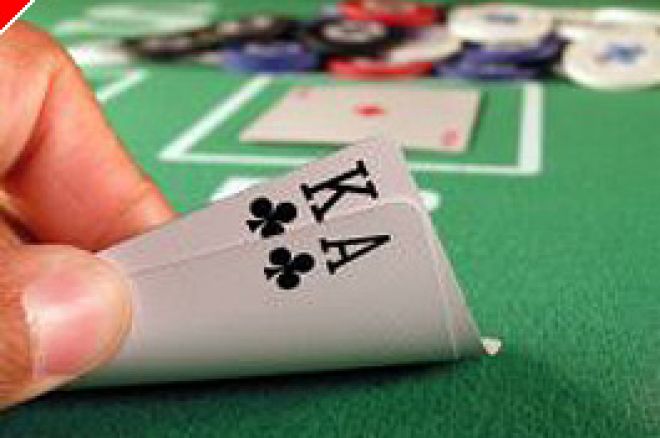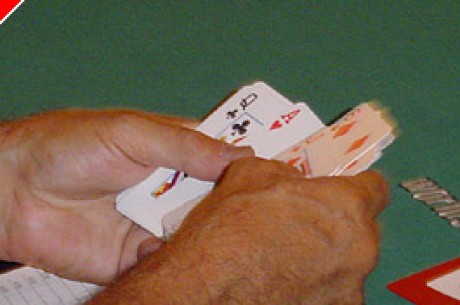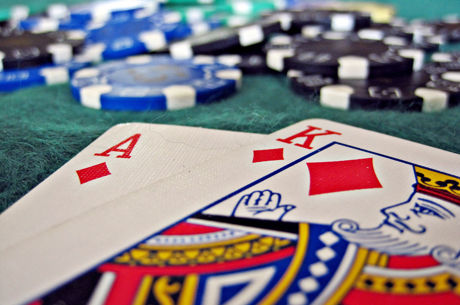Stud Poker Strategy: Roll the Dice

The expression "rolling the dice" usually comes with negative connotations for the poker purist. Meaning "to gamble," it implies that someone is leaving the outcome of an event to chance, as in, "I didn't study at all for this test. I'm just going in there and rolling the dice." And that's the opposite of what we, serious poker players, like to do.
Poker players generally pride themselves on relying on skill as much as possible. This comes through in the derision some poker players spew when their opponents, without apparent regard for skill, manage to win by rolling the dice and "getting lucky." Who among us hasn't heard a player utter "Nice catch" or "You called with THAT??!!" to express his frustration with being outdrawn by an opponent who got lucky when he threw the dice instead of, more skillfully, folding.
Inexperienced or otherwise poor poker players often play poker just as if it were a game of craps. They're dealt cards. They call bets. They show down their hands. If they've been lucky enough to be dealt the best hand they win. If not, they lose. It's just like rolling the dice.
As players learn about the game, however, they learn that certain starting hands are more likely to produce winning hands. They learn, for example, that premium pairs are strong starting cards. Unsuited and unpaired cards are weak. By only playing strong starting hands, they figure out, they increase their chances of winning. And so they develop a tight playing style �C eschewing those low-value hands that have a low probability of winning in the end.
Often, I've noticed, as players recognize the importance of figuring out the relative strength of their hand to the hands they're likely up against, they become significantly tighter in their play. They learn not to chase with hands that are not likely to be the best hand at the time. They stick to those hands that are in the lead. And they bet those leading hands aggressively �C either initiating the betting or raising if someone else opens the action.
As they gain experience, they often become better and better at figuring out whether they are, in fact, in the lead. They start to pride themselves on their ability to lay down a hand that they judge to be second best. But they can learn these lessons too well.
If they hold (J? K?) J? K? 9? Q?, for example, facing an opponent who initiates the betting with (x x) 8? A? 6? A?, they recognize that their kings up is behind what is likely to be aces up. And so, not wanting to roll the dice on the last card, they fold.
Or perhaps, on fourth street, in a relatively loose game with four opponents, they hold (A? Q?) 4? J?. If they're the high hand showing on fourth street, they would routinely check. If the player to their right, showing 9? 10? bets, when everyone else checks to him, they would routinely fold since they didn't catch the fourth spade. They're not willing to "roll the dice" and chase with only a three-flush on fourth street. They're not in the lead, they surmise, and so in their somewhat experienced mind they safely and logically (to them) decline to play rather than to chase with their drawing hands.
The problem is that they have only learned one part of what it takes to be a good poker player.. They have learned that by playing tightly they can avoid some losses. But in so doing they have tried to turn a game of probability into a game of certainty �C by only playing when they view themselves to be in the lead. And in so doing they have virtually eliminated their ability to win in the long run.
There are many potentially profitable poker hands, like the ones illustrated above, that depend on the good player "rolling the dice," allowing himself the chance to play although he may be, at the moment, an underdog. Simply put, there are times when chasing makes sense. By looking more carefully at the above examples you can see why this is so.
In the first example it is indeed true that the player holding the kings-up hand is probably chasing the superior hand of aces up, or even the far superior hand of a flush. It is quite likely that the opponent showing the pair of aces started out either with a pocket pair, a paired door card, or with three suited cards �C in this case clubs. If he held any of those possible starting hands then he would surely be in the lead now �C either with a flush or with aces up. (Roughly 7:1 in his favor if he holds the flush and roughly 2:1 if he holds the aces up). But even so, if the game were even moderately loose early on it surely would make sense to make the call, roll the dice, and see the last card.
You don't have to have a calculator to figure this out. If you figure that the odds are the combination of 2:1 and 7:1 against you, based on the two hands your opponent is likely to have, then you're chances of winning are roughly 4.5:1. The pot, with its combination of dead money from early competitors who dropped off by fifth street, antes, and the bring in, plus your bets and your opponents bets up until sixth street, is likely to be 15 small bets or 7.5 big bets. Your call is one big bet. That means that the pot is laying you roughly 7.5:1 with odds of winning of 4.5:1. Even forgetting the thin possibility that the opponent with aces might not have started with the most likely starting hands (he could have been going for a straight or just impulsively called with three random cards), you've clearly got a good bet �C even though you're behind. So roll the dice here on sixth street and take your chances.
You should roll the dice in the second example from above as well, even though you're likely to be behind. You're close enough and the pot is large enough to justify it. There are a few things you need to consider:
You hold a three-flush that failed to improve on fourth street. (A? Q?) 4? J?. Your betting opponent has two consecutive cards 9? 10?. Two other players, between the two of you, called on third street but checked after you checked on fourth.
Your opponent may have a pair. He is representing one when he bets. If so, if he indeed has a pair of nines, then you're behind with no pair. The skillful, non-dice throwing poker player in you might figure that it makes sense to toss your no-pair hand. But that would be a mistake �C for two reasons.
First, your opponent may not have a pair. It's common for relatively new, somewhat skilled players to see dragons under the bed �C often imagining that their opponents hold the best possible hand. But it's often the case that players don't have what they are representing. In fact, in any game, the last player following a bunch of checking opponents may be betting as a bluff, figuring your checking means you don't have anything and will fold to his bet.
But even if your opponent is not bluffing and has that pair of nines or tens, you're still no worse than a 3:2 underdog to win the hand in a showdown on the river if it's heads up. You may be chasing but you're close behind. And the size of the pot justifies chasing until the river or until his board gets scarier.
Being tight and avoiding risk may be the first baby step you take in improving your poker game. It's the difference between a rank beginner and someone who has read a basic article on good poker player. But tight play alone isn't what makes you a winning player. Making good decisions based on the information you have and can properly infer is the key. Sure, it's simpler just to always take the safer route of folding �C avoiding situations when you're not the favorite. But many profitable situations develop when you are the underdog �� when the pot offers you a sufficient price to roll the dice and see what develops.








